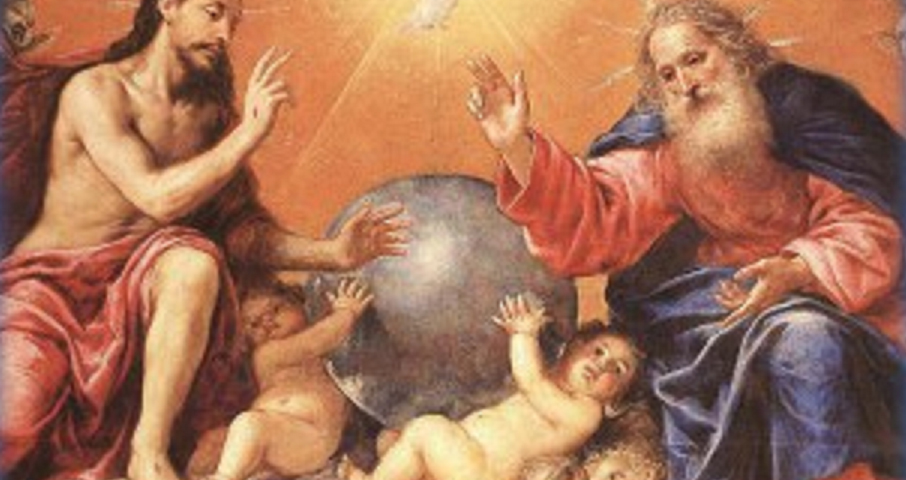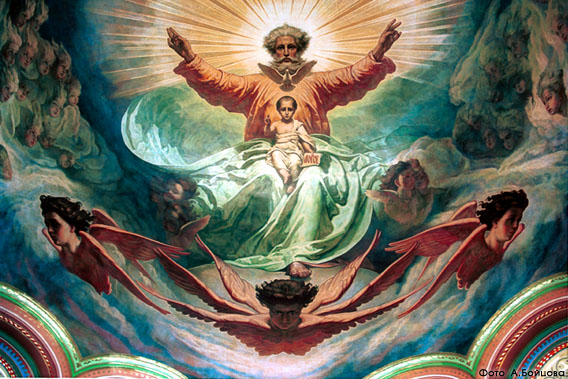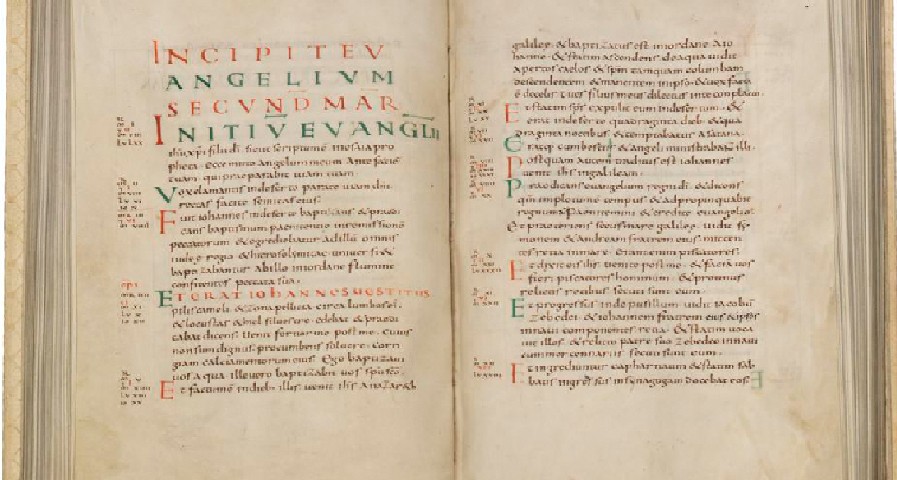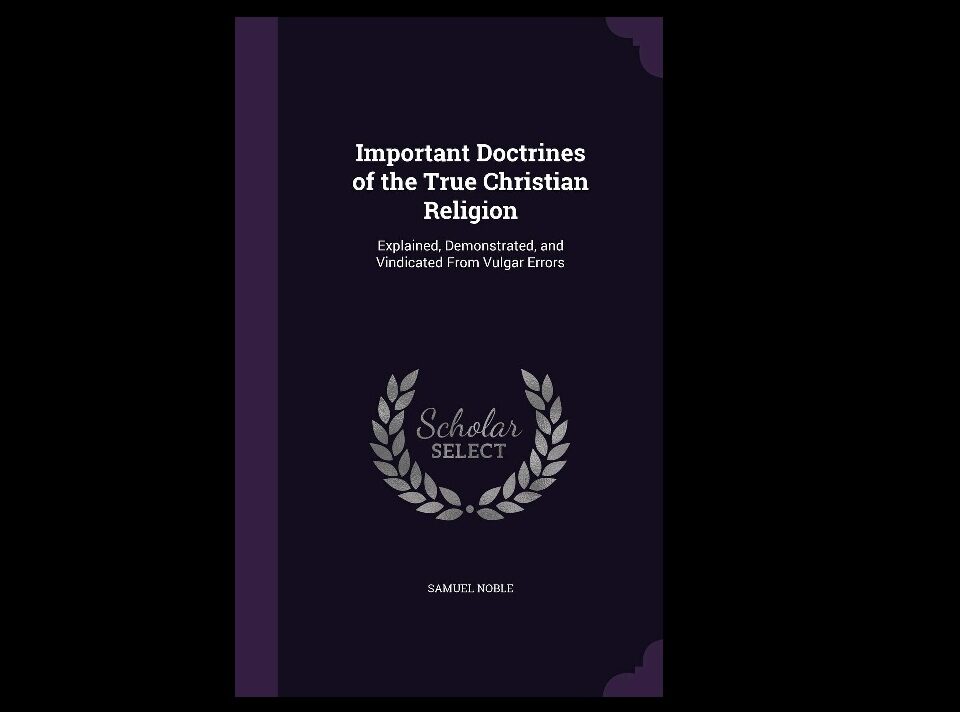
Can the Same Single Line Begin at Two Different Points?
February 1, 2016
“he who was begotten of God”
March 1, 2016Losing Luke and Jumping to John

By Anthony Buzzard
Church members tend to accept without careful examination the “Jesus” presented to them in church. The question of the origin of a person is crucial. A person is defined by his origin. We frequently seek for this information when we ask, “Where are you from?”
The most important question to be asked in relation to the Son of God is about his origin. Where did he come from, how and when? There is a yawning chasm of difference between a person who has existed for eternity as eternal God, before appearing as a human being, and one who begins to exist in the womb of his mother. A genuine human being must, by definition, begin to exist in his mother’s womb!
There is also a chasm of difference between a person who originates as an angel and then reduces himself, or is reduced by God to a fetus and is born from a woman. Hebrews 1:5 and 13 definitively say twice that Jesus was never, ever an angel! But this does not prevent some seven million Jehovah’s Witnesses from asserting the very opposite — that Jesus was in fact an angel, Michael. Such is the power, demonstrably, of deception on a massive scale!
In order to qualify as the promised Messiah. Jesus must be a human person, a lineal, blood relative and descendant of King David. Psalm 132:11 and 89:35-37 (cp. Luke 1:69) make this crystal clear. The Messiah is to be a direct, biological descendant of the royal king of Israel (the genealogy of Joseph as legal father and Mary as actual mother are found in the gospels, both tracing the royal line to Nathan, son of David, Luke 3:31).
The Messiah is in fact the ultimate and final royal ruler of Israel, and he is going to bring peace to our war-torn world. That is the whole point of the Gospel about the coming Kingdom. The government of the world will be on his shoulders (Isa. 9:6). Look around you and be assured that this has never yet happened! But it will.
Luke was a meticulous, educated Christian historian, determined to lay out in order the precise content of the Christian faith (Luke 1:3-4), so that Theophilus, for whom Luke wrote, could be reassured of the absolute accuracy of the Christian facts he had received as the only true faith.
We too are immensely blessed by having the inspired words of Luke, defining with pristine simplicity the true Jesus and the true Christian faith, available all these years later.
The crucial issue is whether we are prepared to believe in the Jesus who was fully a man, descended from David, the second Adam — and of course miraculously fathered, brought into existence in the womb of his mother, by miracle (Luke 1:35; Matt. 1:18, 20, 1 John 5:18, not KJV).
My purpose in this article is to show that the beautifully crafted account by Luke of the origin of Jesus, the Son of God has been subtly undermined, in fact rejected by churchgoers, who unwittingly and uncritically received and continue to receive in church a longstanding tradition about Jesus which negates, obliterates and denies the account given by Luke (and Matthew).
This is a very serious matter of identity and possible mistaken identity! The issue is worthy of our earnest investigation as Bereans (Acts 17:11).
The truth about the identity of the only genuine Jesus of the Bible was of such massive import that God saw fit to dispatch the angel Gabriel to communicate the vital identity facts necessary for clear understanding. When angels speak we are meant to pay close attention! When angels communicate we may take it for granted that they were skilled enough with words to be easily comprehended.
The Bible was never intended to be a brain-breaking, inscrutable puzzle fit only for learned experts! You, as a devoted lover of God and Jesus, can understand who Jesus is! And you must, on pain of remaining in a colossal muddle and misunderstanding of easy language.
We remember that Gabriel was commissioned to perform a task on behalf of God on two momentous occasions. Firstly in Daniel 9, where Daniel, in deep distress over the disastrous condition of Jerusalem and the Temple, begs God to forgive his own and his nation’s sins and restore peace and security to Israel. Daniel’s impassioned pleas are met by an extraordinary visit from Gabriel, speaking for the One God. Daniel is given blessed reassurance, in answer to his persistent question about “how long” it will be before final restoration comes. He is told that at the end of a period of 70 “sevens,” 490 years, all will be finally well. Restoration will come to Jerusalem and Israel.
The fanciful idea that the prophetic period of 490 years would end in either 33 AD or alternatively in 70 AD should be set aside as quite untrue! It would be the worst sort of cynicism to offer Daniel a “resolution” of his prayer request, by telling him that at the end of 490 years the city would experience another equally appalling disaster! As is well known, the Romans devastated Jerusalem, burned the temple and killed or deported well over a million Jews! This happened in AD 70. That event is certainly not the fulfilling of a prophecy about restoration!
All the great prophecies in Daniel, who lived in the sixth century BC, terminate in the only climax which ultimately counts, the future establishment of the Messianic Kingdom of GOD on earth, to be introduced by Jesus at his second coming (chs. 2, 7, 8, 9, 11, 12).
The other equally momentous occasion for which Gabriel was dispatched on an amazing mission, was his visit to the young Jewess, the virgin Mary, who was engaged to Joseph. These were members of the royal house of David, scrupulously recorded by public genealogies, not currently ruling of course as royal family, and it was to that family that the Messiah had to be born. The integrity of the whole of Scripture was at stake.
Luke is most specific in his detailing of how and when and where the promised Messiah would originate. The first important fact to note is that Luke did not describe the arrival, from outside the womb, of a “preexisting” second member of a triune Godhead! It is regrettably confusing to read one’s own traditions into Luke’s account and thus alter it, falsify it, drastically. This is unfair treatment of Holy Scripture. Luke deliberately excludes any idea that the Son of God, whom Luke says was fathered by miracle in Mary and born to Mary, was already alive before being conceived! Could it be that your church’s misreading of Luke confuses the identity of Jesus?
Here is how Luke details the vastly important event of the origin and thus identity of the Son of God, Jesus. Luke recalls first that Zacharias had been punished with loss of speech for nine months, for having refused to believe the straightforward words of the angel Gabriel: that his elderly wife Elizabeth would, contrary to normal expectation, become pregnant and bear John the Baptist (Luke 1:19-20).
Then comes the astonishingly significant visit of Gabriel, in the 6th month of Elizabeth’s pregnancy (Luke 1:26). The angel reassures Mary, who was very naturally alarmed at the appearance of an archangel in her house, that she is not to be afraid (Luke 1:30).
Gabriel then explains in easy, clear and concise language, how and when the promised Messiah was to come into existence. The biblical words are offered to us all as powerful, up-building information, certainly not as a matter for argument or dispute!
“The holy spirit, the power of the Most High God” was to overshadow her, and “precisely for that reason” (dio kai), the one to be begotten, fathered, would be “called the Son of God” (Luke 1:35). (Avoid the deceptive addition of “also” in the KJV!) To be called Son of God, to be Son of God, is an identity statement. Son of God would be exactly who the one begotten = brought into existence would be! There is not the slightest difficulty or complication about this matchless account. It is lucidly clear. It must be believed as a fundamental building block of Christian faith.
It was meant to be definitive and decisive, and worthy of all trust. Unifying and comforting. Every NT writer based his understanding of who Jesus was and is on these inspired instructions of Gabriel. The NT does not present the hopelessly confused denominational scene of today. That chaos should alert us to the fact that something terribly wrong has happened! Could this be the problem?
“Christendom has done away with Christianity without being quite aware of it” (Soren Kierkegaard, cited in Time magazine, Dec. 16, 1946).
The Messiah would evidently be related to David by being conceived and begotten in the womb of one who was of royal blood, and that person, so conceived and begotten, would therefore be the Son of God, precisely for this one easy reason — God was Jesus’ Father by biological miracle wrought through holy spirit, the creative power of God. This miracle occurred in Jesus’ mother Mary. In this way, too, the son of Mary/Son of God would qualify as the second and final Adam, who is also son of God (Luke 3:38).
We are blessed by having a superb and detailed account of and commentary on the birth narratives by the late Raymond Brown. This is a classic analysis of the detail of Luke and Matthew’s account of the origin of the Son of God, Messiah Jesus.
Brown points to an amazing fact! Church tradition about a second member of the Godhead wiped out the account given by Luke, altering it and explaining it away. Brown’s comments should cause urgent rethinking. They are cause for alarm. Brown points out that a fundamental obscuring of Luke’s and Gabriel’s words occurred when later tradition altered the account, by imposing on it the alien idea that the Son of God did NOT begin in the womb of his mother, as every human being by definition must.
Brown says, “For preexistence…the conception of Jesus is the beginning of an earthly career but not the begetting [bringing into existence] of God’s Son.” The later idea of a “preexisting” Son canceled and contradicted Luke’s account of the beginning of the Son of God. “The virginal conception,” Brown says rightly, “was no longer seen as the begetting of God’s Son, but as the Incarnation of a [preexisting] Son, and that became orthodox doctrine” (The Birth of the Messiah, p. 141). I hope our readers will receive a salutary shock from this amazing admission.
Note that Luke’s account was directly contradicted and annulled by the later view which became orthodox, i.e. required by dogma to be believed by church members. As Brown says, as soon as the later preexistence theory became standard orthodox belief, “the virginal conception/begetting was no longer seen as the begetting of God’s Son.” Luke and Gabriel were, in other words, no longer believed as revealing the true account of the origin of the Son of God! The point of origin and thus the identity of Jesus, Son of God, was radically altered. “Orthodoxy” contradicted and superseded Luke, Gabriel and the Bible! This shift ought really to be called what it in fact was and is — a departure from Scripture and the imposition of a new and different identity on the Son of God. Is no one alarmed by this re-identification of the Son of God? Does no one see the disturbing possibility that a “different Jesus,” a “different Christ” was smuggled in? “Church” could be much more of a “crime scene” than you imagined!
That new unbiblical origin and identity of the Son of God replaced the scriptural one announced by God through Gabriel, and that new unscriptural account took up residence as orthodox and standard in all the denominations! Few seem to have thought about the consequences of any interference with Luke and Matthew regarding the keys to the true Son of God.
We saw how refreshingly frank Raymond Brown was in his classic account of The Birth of the Messiah. He pointed to the subtle shift by which tradition negated Luke and Gabriel. Luke’s account was “no longer” allowed to speak in church, once tradition took over. Tradition swamped Luke and Gabriel and swamps them to this day.
According to Luke, Mary is the one through whom and in whom the Son of God is brought into existence, fathered by miracle, begotten as unique Son of God. Jesus is the Son of God from the moment of his beginning to exist, i.e. the conception/begetting which took place in Mary. This is transparently clear and should not provoke any argument. Mary did not argue with Gabriel, or misunderstand him, but today many are ready to bury the truth of Gabriel’s words in brain-breaking argumentation!
Brown takes note of the “crime scene” to which Luke’s simple account became subject.
“Some church fathers and medieval theologians thought that the reference in Luke 1:35 [‘the holy spirit and power of God’] referred respectively to the third and second Persons of the Trinity, so that ‘power’ was the second Person descending to take ‘flesh’ in Mary’s womb. As we shall see there is no evidence that Luke thought of the Incarnation of a pre-existent Son” (p. 290).
The tragic overlaying of Luke with pagan philosophical ideas of a Trinitarian Godhead should be exposed and rejected. Brown goes on to remark how embarrassing Luke 1:35 was to the Church leaders. He comments on the all-important causal “therefore” in Luke 1:35. This links the virginal begetting explicitly to Jesus being the Son of God.
“This has embarrassed many orthodox theologians, since in preexistence [Trinitarian] Christology a conception by the Holy Spirit in Mary’s womb does not bring about the existence of God’s Son. Luke is unaware of such a Christology. For Luke conception is causally related to divine Sonship” (p. 291).
There is a glaring mismatch between Luke and Scripture and what developed from the second century as dogma.
The flagrant contradiction of Luke by “theology” must not be missed, since it calls in question the whole of tradition for the past 1900 years. Raymond Brown drives his point home:
“I cannot follow those theologians who try to avoid [try to avoid the Bible!] the connotation in the word ‘therefore,’ which begins this line. They argue that for Luke the conception of the child does not bring the Son into being, but only enables us to call him Son of God who already was Son of God.”
Brown summarizes his biblical findings with this: “Both narratives develop the Christological insight [how to define the identity of the true Jesus] that Jesus was the Son of God from the first moment of his conception” (p. 561). Not before!
That of course is straightforwardly and factually true, and it should cause readers to wonder with some urgency if they are learning the real account of the real identity of the real Jesus of history, of the Bible and of faith.
The contradiction is simple: Luke and Matthew based the fundamental identity of the Son of God, the Messiah, on the marvelous miracle effected by God in Mary. The connection is logical and absolutely clear. Its meaning really cannot be avoided. Gabriel was delightfully free of the waffly, confusing language so often found in some writing on the Bible.
The cause of the endless argument and inconclusiveness, and also often fierce dogmatism, is really the church tradition which has taken us all away from Scripture. If tradition were laid aside, we could all experience the joy of being in touch directly with the inspired words of Luke and Matthew and Gabriel.
We would then stop using John to contradict Matthew and Luke. We would not rush to John 1:1 and read it in a way which would confuse and obfuscate Matthew and Luke. John would be seen as announcing the plan and design of God: the word, not Word, from the beginning. Not the existence of a second GOD (the Son) which violates the creed of Israel and of Jesus (Mark 12:29; John 17:3) and negates the obvious contrast between the One God (Yahweh) and the Messiah who is the non-Deity “my lord” (adoni) of Psalm 110:1. This is the most favorite verse from the OT in the NT and it should act as a warning barrier against interfering in any way with the most important of all commands, affirmed by Jesus in Mark 12:29 and John 17:3. God is a single Divine Person, so described by thousands of singular personal pronouns!
More on the Crime Scene: the “Nunc Stans”
What on earth is that, you may well ask? It is the Latin phrase (“standing now”) meant to describe the idea that for God all time is present!
“Nunc stans” is the “eternal now,” the idea of eternity as standing still in the present. You could conceive of being around eternally as being around to watch all of history happen forever, but the idea of nunc stans is as if you experience all of time in a single moment which never ends. So a God who perceives the nunc stans would know everything that has happened and that will happen at the same moment for all eternity. It would be like being able to see all of time spread out before Him in another dimension or something.
Now comes the crunch! Let our readers pause and think here! In Psalm 2:7 we read a brilliant statement about the origin of the Son of God. It is God Himself who utters the following proposition: “You [the Messiah] are My Son: Today I have become your Father = brought you into existence.”
When you go to church in a Protestant or Catholic setting you are committing yourself to the belief that the “today” of the begetting, coming into existence of the Son (Ps. 2:7; repeated in LXX Ps. 110:3) is not a day in time, but an endless day, because with God there is no today!
This argument was constructed by the church fathers of the 4th century in order to justify the belief that Jesus is the eternal Son of God, who had no beginning in time. As one of the church fathers wrote, “The Son had a beginningless beginning.”
Now the critical question: Is that notion of a “beginningless beginning” and the companion idea that “today” with God means endless time an honest and honorable concept? Or is it sheer obfuscation and confusion of easy language?
One is reminded of a drug company selling the benefits of its new therapy. But hidden from the public are some dire side effects. In church the pew-sitters seem so little interested in the basis of their avowed belief. Do they know or care that the engineers and fabricators of their central doctrine about Jesus as GOD THE SON, the “eternally begotten Son,” were candid enough to say that belief in God the Son automatically commits you to believing that “today with God does not and cannot mean ‘today’”? Is “beginningless beginning” a fit phrase for rational, intelligent human beings? How about “1+1+1=1” which millions of believers do not hesitate to declare as central dogma?
Let us finish by inviting you to ponder the words of world famous Christologist Dr. James Dunn: “There is of course always the possibility that ‘popular pagan superstition’ became ‘popular Christian superstition,’ by a gradual assimilation and spread of belief at the level of popular piety” (Christology in the Making, p. 251).

